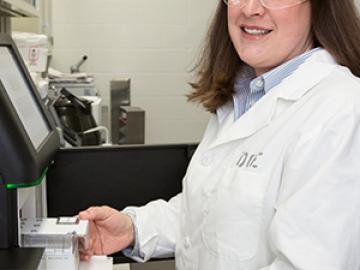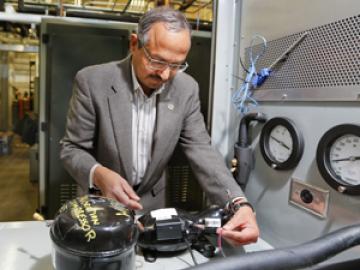Filter News
Area of Research
- (-) Clean Energy (110)
- (-) Energy Frontier Research Centers (7)
- Advanced Manufacturing (10)
- Biological Systems (3)
- Biology and Environment (37)
- Biology and Soft Matter (1)
- Building Technologies (3)
- Chemical and Engineering Materials (2)
- Chemistry and Physics at Interfaces (6)
- Computational Biology (1)
- Computational Chemistry (1)
- Computational Engineering (2)
- Computer Science (4)
- Electricity and Smart Grid (1)
- Functional Materials for Energy (6)
- Fusion and Fission (14)
- Fusion Energy (2)
- Geographic Information Science and Technology (2)
- Isotope Development and Production (1)
- Isotopes (12)
- Materials (54)
- Materials for Computing (18)
- Materials Synthesis from Atoms to Systems (5)
- Materials Under Extremes (6)
- Mathematics (1)
- National Security (7)
- Neutron Data Analysis and Visualization (2)
- Neutron Science (26)
- Nuclear Science and Technology (7)
- Quantum Condensed Matter (2)
- Quantum information Science (3)
- Reactor Technology (1)
- Sensors and Controls (1)
- Supercomputing (41)
- Transportation Systems (3)
News Type
News Topics
- 3-D Printing/Advanced Manufacturing (25)
- Advanced Reactors (1)
- Artificial Intelligence (1)
- Big Data (3)
- Bioenergy (3)
- Biology (5)
- Biotechnology (1)
- Buildings (11)
- Chemical Sciences (1)
- Clean Water (1)
- Climate Change (4)
- Composites (5)
- Computer Science (4)
- Coronavirus (2)
- Critical Materials (3)
- Decarbonization (5)
- Energy Storage (20)
- Environment (12)
- Grid (8)
- High-Performance Computing (4)
- Materials (17)
- Materials Science (6)
- Mathematics (1)
- Microscopy (1)
- Nanotechnology (2)
- Net Zero (1)
- Neutron Science (2)
- Nuclear Energy (1)
- Polymers (3)
- Security (1)
- Space Exploration (1)
- Statistics (1)
- Summit (1)
- Sustainable Energy (24)
- Transportation (16)
Media Contacts


Less than 1 percent of Earth’s water is drinkable. Removing salt and other minerals from our biggest available source of water—seawater—may help satisfy a growing global population thirsty for fresh water for drinking, farming, transportation, heating, cooling and industry. But desalination is an energy-intensive process, which concerns those wanting to expand its application.

Graphene, a strong, lightweight carbon honeycombed structure that’s only one atom thick, holds great promise for energy research and development. Recently scientists with the Fluid Interface Reactions, Structures, and Transport (FIRST) Energy Frontier Research Center (EFRC), led by the US Department of Energy’s Oak Ridge National Laboratory, revealed graphene can serve as a proton-selective permeable membrane, providing a new basis for streamlined and more efficient energy technologies such as improved fuel cells.

Andrew Stack, a geochemist at the Department of Energy’s Oak Ridge National Laboratory, advances understanding of the dynamics of minerals underground.


The Department of Energy’s Oak Ridge National Laboratory and Whirlpool Corporation are collaborating to design a refrigerator that could cut energy use by up to 40 percent compared with current models

With a 3-D printed twist on an automotive icon, the Department of Energy’s Oak Ridge National Laboratory is showcasing additive manufacturing research at the 2015 North American International Auto Show in Detroit.




